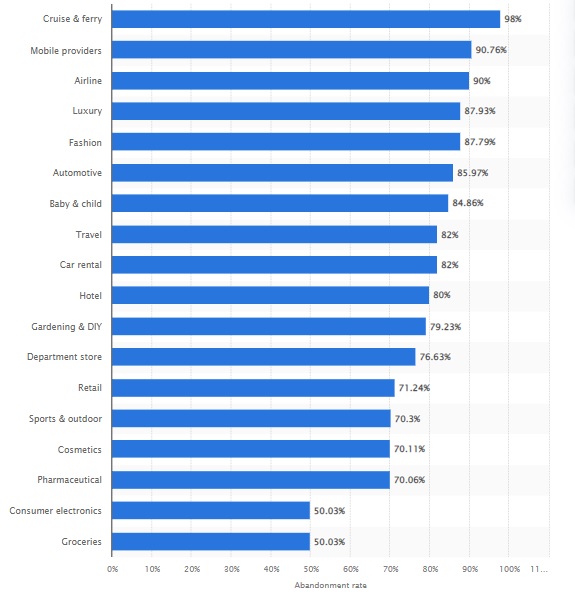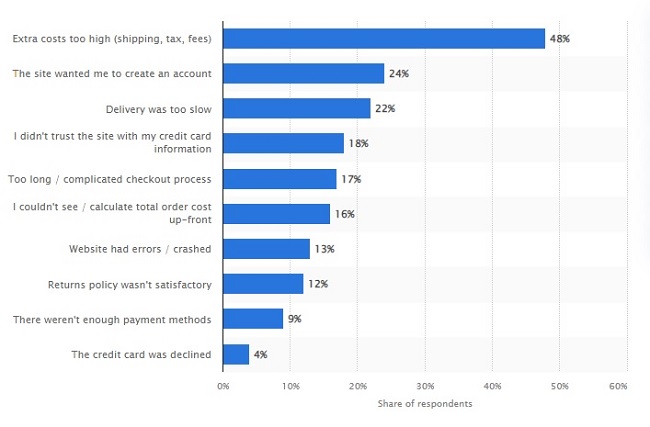The ecommerce sector can be divided into business-to-consumer (B2C) and business-to-business (B2B). The customer is the driving force behind the purchase; in the latter, it is the business. It is often the case that the consumer is king in ecommerce, which brings a host of considerations for businesses. One such consideration is shopping cart abandonment.
Shopping cart abandonment occurs when a customer adds items to their shopping cart but then leaves the ecommerce store without making a purchase. A shopping cart abandonment rate typically indicates a problem with the checkout process. Therefore, if ecommerce store owners want to recover possibly lost revenue and increase conversions, they must track this metric.
Why is Shopping Cart Abandonment a Significant Issue for Ecommerce Sites?
Think how many resources are used to get a shopper to visit your site and become so engaged with a product that they add it to their cart. If they leave, you'll have to spend more resources to return them. However, you can avoid paying for all those extra resources by simply adjusting something on your site, which is often very easy but labor-intensive.

Source: Statista
During 2022, many online shopping orders were left incomplete, meaning they were not finalized as purchases. The category with the highest cart abandonment rates, measuring around 98%, was websites providing cruise and ferry travel services.
Furthermore, if that customer does not return to your site and complete the transaction, the ecommerce shopping cart represents potential revenue lost. Although shopping cart abandonment is common, it is essential to recognize that individuals have unique preferences and shopping habits that can change over time. Therefore, it may not be feasible to eliminate the shopping cart abandonment process. However, it is possible to reduce cart abandonment by developing effective business strategies that suit your specific needs and goals.
The average conversion rate for ecommerce varies by industry, and many factors can impact conversion rates, including website design, product selection, pricing, shipping options, and marketing tactics. Therefore, implementing shopping cart abandonment solutions to reduce cart abandonment can be a helpful strategy for ecommerce businesses looking to boost their sales.
Importance of Reducing Shopping Cart Abandonment
Reducing shopping cart abandonment is crucial for ecommerce businesses because it directly impacts their sales and revenue. When customers drop items from their shopping cart, they are interested enough in the products or services to add them to their cart, but something stops them from completing the purchase. It can be frustrating for businesses, as they have already invested time and resources into acquiring the customer's attention and interest.
Moreover, shopping cart abandonment is common in the ecommerce industry. As a result, businesses could lose a significant portion of their sales. By reducing the shopping cart abandonment rate, companies can improve their sales and revenue while increasing customer loyalty and engagement. In addition, by implementing shopping cart abandonment solutions to reduce cart abandonment, companies can optimize their sales funnel and provide a better user experience for their customers.
Calculate the Shopping Cart Abandonment Rate
Calculating the shopping cart abandonment rate is relatively simple.

The formula to calculate the shopping cart abandonment rate is as follows:
| 1 - (Number of Completed Purchases / Number of Shopping Carts Created) x 100 |
This formula gives the percentage of shopping carts created but not converted into completed purchases. You get the cart abandonment rate by subtracting the conversion rate from 100%. This metric helps businesses assess their sales funnel's effectiveness and identify improvement areas.
For example, if you had 1,000 shopping carts created during a given period and only 750 resulted in completed purchases, the shopping cart abandonment rate would be calculated as follows:
| 1 - (750/1000) = 0.25 or 25% |
It indicates that 25% of shopping carts were abandoned during that period. By tracking this metric over time, ecommerce businesses can identify potential issues in the purchase process and implement strategies to reduce cart abandonment and improve sales.
10 Strategies to Reduce Shopping Cart Abandonment
To minimize the occurrence of shopping cart abandonment, there are several effective methods to consider. In this regard, here are 10 strategies that can significantly reduce instances of shopping cart abandonment rate.
Offer Free Shipping
Offering free shipping is a strategy to reduce cart abandonment and increase sales. It involves absorbing the cost of shipping for customers by setting a minimum order amount or offering free shipping across the board. This strategy can be effective in attracting and retaining customers who are sensitive to shipping costs. However, it's essential to consider the impact on profit margins and optimize shipping methods and costs to minimize expenses.
Allow for Guest Checkout
Making customers register and create an account before entering the checkout process can be a barrier to purchase. With guest checkout, customers can complete their purchases without creating an account, making the checkout process faster and more convenient.
By offering this option, you can appeal to customers who don't want to create an account or provide personal information, increasing the likelihood of a successful transaction. It can also help attract new customers who are unfamiliar with your website and may be hesitant to create an account immediately. Overall, enabling guest checkout is a simple but effective strategy for reducing the shopping cart abandonment rate and improving the customer experience.
Offering Multiple Payment Solutions
By offering customers different payment options, such as credit cards, PayPal, Amazon Pay, Apple Pay, Google Pay, etc., customers are more likely to complete the checkout process because they can choose a payment method that suits them best. For instance, some customers may prefer a specific payment method for security reasons, while others may prefer a payment method that offers cashback or rewards. In addition, by providing multiple payment options, online retailers can cater to the needs and preferences of a broader range of customers, resulting in higher conversion rates.
Customers appreciate the convenience, and providing various payment options can make their shopping experience easier and more seamless. A positive shopping experience will also increase the possibility that customers will return to the retailer and recommend it to others.
Therefore, offering multiple payment solutions is beneficial for reducing shopping cart abandonment, building a strong relationship with customers, and increasing brand loyalty.

Source: Statista
In 2022, many U.S. consumers were prevented from completing their online purchases at checkout due to additional costs, such as shipping fees, taxes, and other charges. Additionally, many online shoppers in the United States opted out of their purchases for two significant reasons: being prompted to create an account on the website and experiencing slow delivery times.
Utilizing Exit-Intent Popups
Exit-intent popups are triggered when a shopper moves their cursor towards the browser's top or side to exit the page, indicating an intention to leave the website without purchasing. Exit-intent popups can offer discounts, free shipping, or other incentives to encourage shoppers to complete their purchases. By providing an attractive offer when shoppers are about to leave, businesses can nudge them towards making a purchase and increase conversion rates.
Simplify Your Checkout Process
Simplifying the checkout process is a crucial strategy to reduce shopping cart abandonment. Retailers can implement several measures to streamline the process and make it more user-friendly for customers. For instance, minimizing the number of steps required to complete the purchase, reducing the number of form fields to fill out, and allowing guest checkouts can make the process smoother and faster. Additionally, retailers can offer multiple payment options and display a progress bar to keep customers informed about their progress during the checkout process.
Retailers can also offer free shipping or returns to incentivize customers to complete their purchases. Providing clear and concise information about the product, including product images, descriptions, and reviews, can also help build trust with the customer and reduce the likelihood of abandonment. By implementing these strategies, retailers can simplify the checkout process, reduce cart abandonment, and increase sales.
Auto-apply Coupons
This tactic automatically applies a discount code or coupon to customers' shopping carts when they abandon them before purchasing. It aims to entice customers to complete their purchases by offering them a discount without requiring them to take any additional steps. In addition, the auto-apply coupon strategy can help reduce cart abandonment rates by making the checkout process more convenient for customers.
Implementing an auto-apply coupon strategy can help retailers track their customers' behavior and preferences. Retailers can use data from the auto-apply coupon system to analyze which coupons are most effective in converting abandoned carts into completed purchases. You can use this information to adjust coupon offers and improve the strategy's effectiveness. By using an auto-apply coupon system, retailers can boost sales, reduce cart abandonment rates, and gain valuable insights into customer behavior.
Include Security Symbols
Security symbols are an essential aspect of online shopping that can help build trust between customers and retailers. These symbols indicate to customers that a website or online retailer has taken steps to protect their personal and financial information. By prominently displaying security symbols on their website, online retailers can help reduce the number of shopping cart abandonments caused by concerns over security and fraud.
One strategy for using security symbols to reduce shopping cart abandonment is to display them prominently throughout the checkout process. It can include showing security badges on the shopping cart page, the checkout page, and any other pages related to the payment process. Additionally, retailers should ensure that the symbols they use are widely recognized by customers and associated with trusted security providers. By doing so, retailers can help reassure customers that their personal and financial information is safe and secure, which can lead to increased conversion rates and reduced cart abandonment.
Improve Page Load Times
Large and uncompressed images can significantly slow down page load times, leading to frustration for users and increasing the likelihood that they will abandon their shopping carts. By compressing and optimizing images, website owners can scale down the size of the images without compromising on quality, improving page load times and enhancing the user experience. Additionally, lazy loading techniques can reduce page load times by only loading images as needed rather than all at once.
Another strategy to improve page load times and reduce cart abandonment is implementing a content delivery network (CDN). It's a server network that distributes website content across multiple locations worldwide, allowing users to access content from the server closest to their location. As a result, it can significantly reduce the time it takes users to access the website content, including product images, descriptions, and checkout pages. By improving page load times with a CDN, website owners can reduce the possibility of shopping cart abandonment and increase conversions.
Add a Live Chat Option
By offering customers real-time assistance, you can help them overcome any obstacles preventing them from completing their purchases. First, select a live chat tool that integrates with your ecommerce platform to implement this strategy. Then, ensure that the chat option is prominently displayed on the checkout page and a clear message inviting customers to reach out if they have any questions or concerns.
Consider using targeted chat triggers, such as pop-ups that appear when a customer has been inactive on the checkout page for a certain amount of time. By proactively engaging with customers, you can increase the likelihood that they will complete their purchase and reduce the shopping cart abandonment rate.
Create Abandonment Cart Email Flows
This strategy involves sending personalized emails to customers who have abandoned their carts to convince them to complete their purchase. The abandonment cart email flow can be divided into several stages, each with a different message. You should send the first email after the customer has abandoned their cart, reminding them of the items left behind and offering incentives such as discounts or free shipping. The subsequent emails can follow up with additional offers or reminders while creating a sense of urgency by highlighting limited stock or time-sensitive promotions. By creating a well-crafted abandonment cart email flow, retailers can effectively engage with customers and increase the chances of converting abandoned carts into successful purchases.
Shopping cart abandonment solutions are strategies and techniques businesses use to encourage customers to complete their purchases and reduce the number of abandoned carts. The above shopping cart abandonment solutions are critical for companies to reduce the number of abandoned carts and increase their revenue. By combining these strategies, companies can improve their customers' shopping experiences and encourage them to complete their purchases.
Conclusion
Shopping cart abandonment can significantly impact the revenue and success of an online business. Companies can implement various shopping cart abandonment solutions, as listed above, to reduce cart abandonment. By implementing effective strategies to reduce cart abandonment rate, companies can increase their chances of converting potential customers into paying ones.
Remember that abandoned purchases do not indicate that your sale is over. Instead, retarget your lost leads with email marketing and welcome them back to your store, where you can help them with their purchase. You must work with a professional ecommerce website development company to establish a successful website for your online business.
